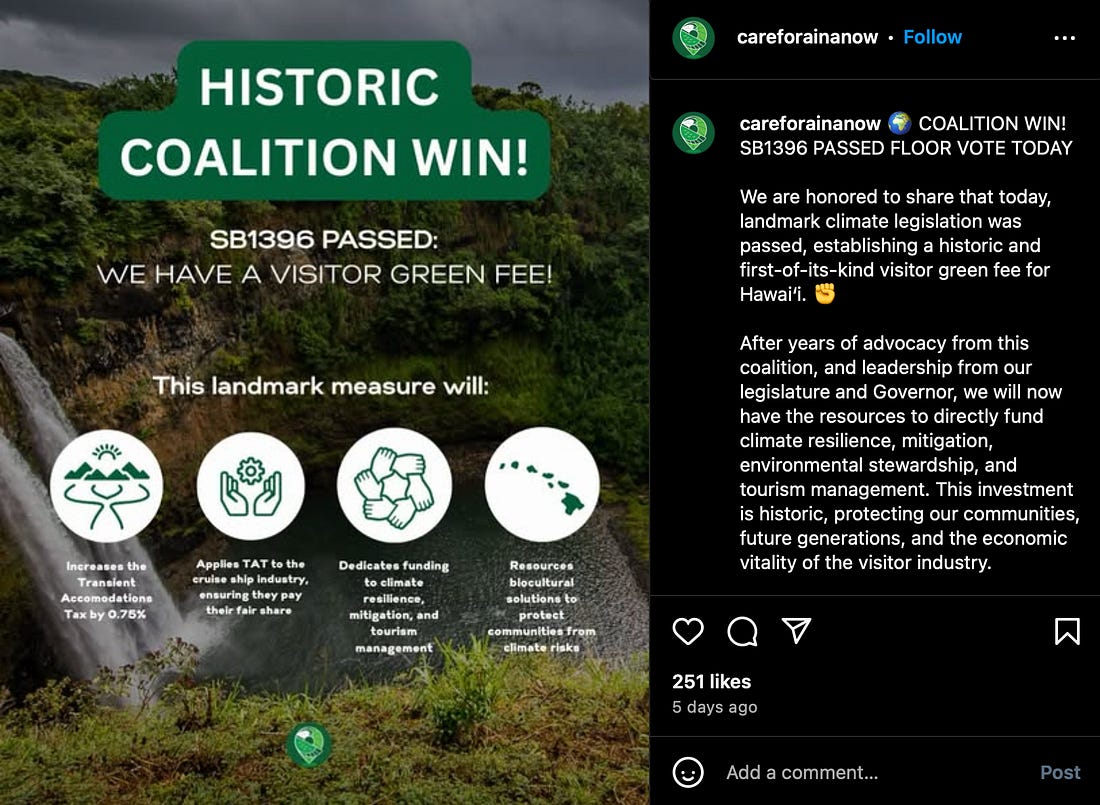|
 |
IMPORTANT ALERT: I’m running low on pet pics! If you’ve got a cute one—or an ugly one, I don’t care—send a photo with some words to catchoftheday@heated.world. Thanks!
The reality of Hawaii's tourist climate tax
A .75% tax will not destroy Hawaii's economy. But unchecked climate change will.
 |
Here’s something you don’t hear every day: A notable climate change law is about to be signed in the United States.
Hawaii state lawmakers on Friday approved what’s known as the “green fee,” a first-of-its-kind effort to charge visitors for climate adaptation efforts. Once signed into law by Gov. Josh Green, the green fee will raise Hawaii’s existing transient tax on hotel rooms, vacation rentals and other short-term accommodations from 10.25 percent to 11 percent starting next year. Cruise ship passengers docked at Hawaiian ports will also be charged an 11 percent transient tax per night.
The increased revenue from that by .75 percent tax increase—expected to be about $100 million per year—will be earmarked specifically for projects like coral reef restoration; sand replenishment for eroding beaches; hurricane preparation; and removal of invasive grasses like the ones that fueled the deadly wildfires in Lahaina, according to the governor’s office.
“Given the devastation we saw on Maui in August of 2023, this measure is crucial because it will help us to deal with wildfire risk resulting from the climate change crisis,” Green said in a statement.
The measure is significant because it marks the first time a U.S. state has ever charged visitors for environmental conservation efforts. It also took years for activists to accomplish. “It's something that people like me have been calling for for over a decade now, and started off as a pipe dream,” Kaniela Ing, a native Hawaiian organizer and national director of the Green New Deal Network, told HEATED. “It's monumental, because it shows that the organizing has paid off.”
 |
The money raised from the visitor green fee won’t be enough to cover all of Hawaii’s conservation needs, however. According to an analysis released this year by Care for ʻĀina Now, the state needs at least $560 million per year to offset the environmental effects of tourism and adapt to the worsening impacts of climate change.
But Hawaii isn’t expecting tourists to foot the entire bill. It’s trying to make polluters pay, too.
Last week—one day before the Legislature passed the visitor green fee—Hawaii Attorney General Anne Lopez filed a lawsuit against seven oil and gas companies and the American Petroleum Institute, seeking to recover damages for costs associated with worsening storms, wildfires, and coastal erosion from sea level rise.
In her strongly-worded 196-page complaint, Lopez accused fossil fuel companies of failing to warn Hawaii consumers about the consequences of their products, and engaging in a massive cover-up to hide those consequences:
Starting no later than the 1980s, Defendants have spent millions of dollars orchestrating a massive disinformation campaign to cast doubt on the science of climate change; to shuttle climate denialist theories into mainstream media and science despite the fact that Fossil Fuel Defendants’ own scientists had already debunked those theories; and to conceal the role of fossil fuels in driving the climate crisis …
If not for Defendants’ tortious and deceptive conduct, the damaging consequences of climate change in Hawaiʻi would have been far less extreme than those currently occurring ….Hawaiʻi seeks to ensure that the parties who have profited from deceiving consumers and the public about climate change bear the costs of that deceptive commercial activity.
Indeed, Ing told me he’s seeing the effects of fossil fuel industry disinformation in Hawaii get worse every year, no doubt aided by the rise of an unapologetic climate denier president. “I have friends who used to be all about climate who literally call it a hoax now,” he said. “It’s like t